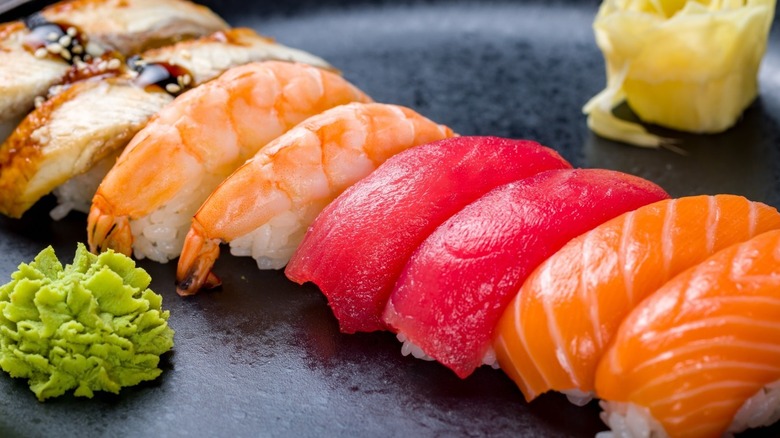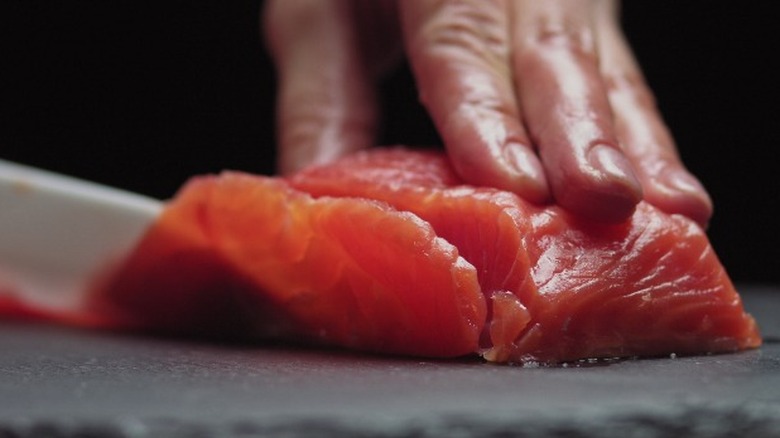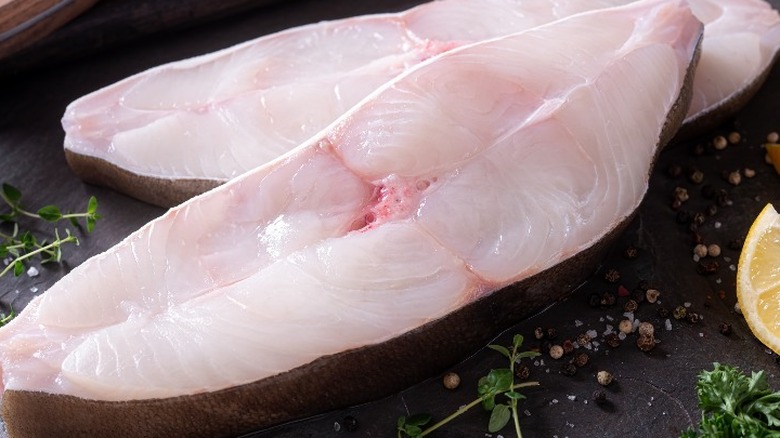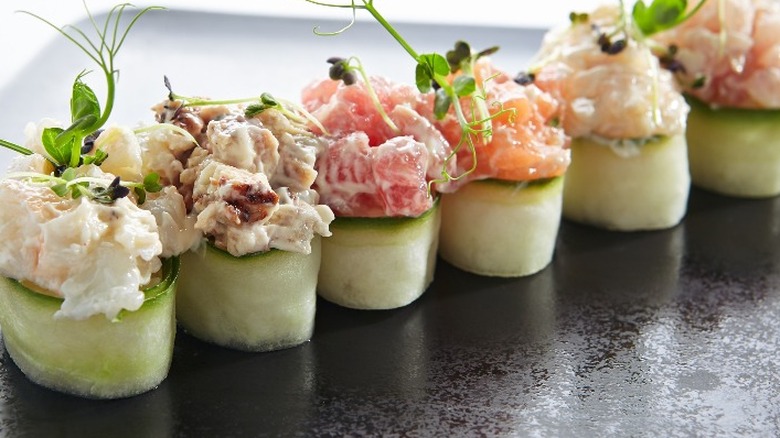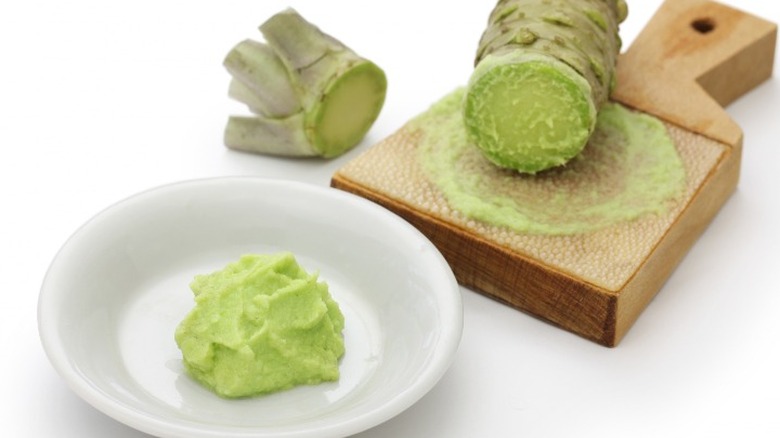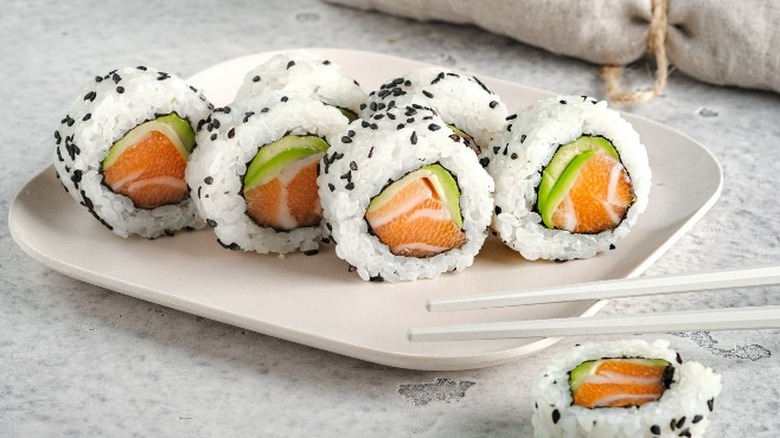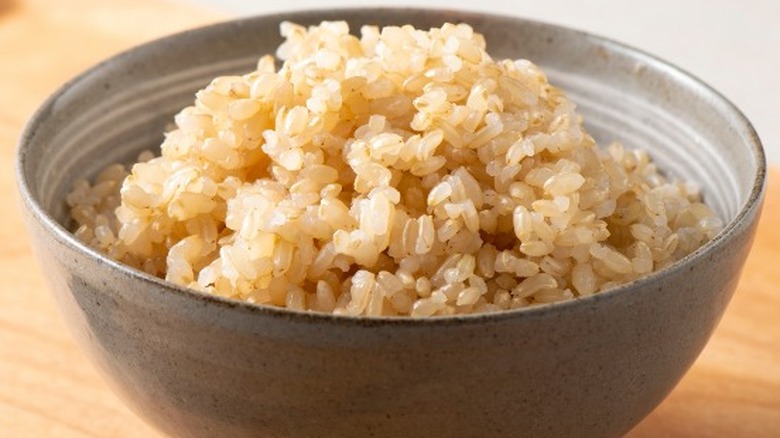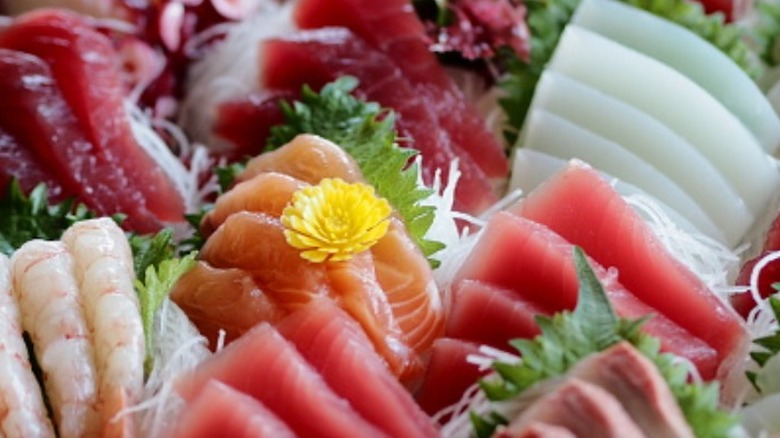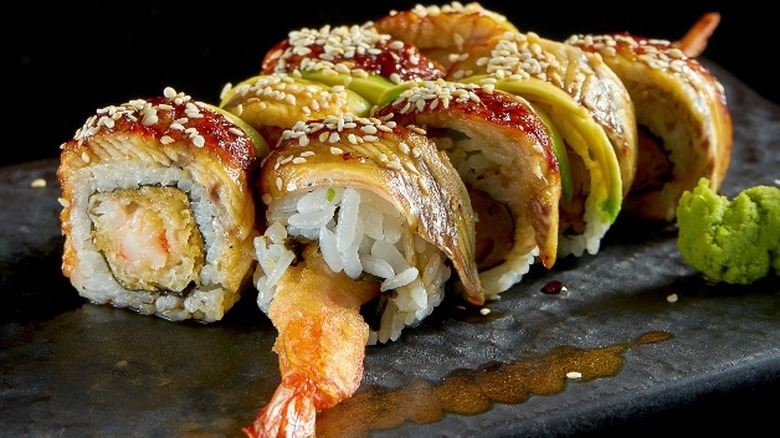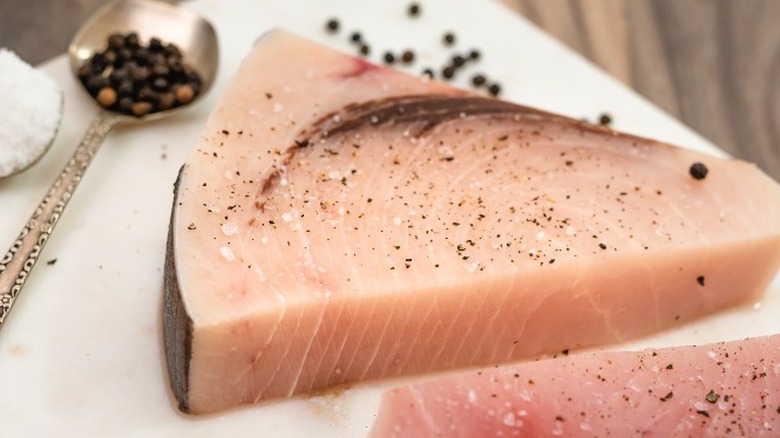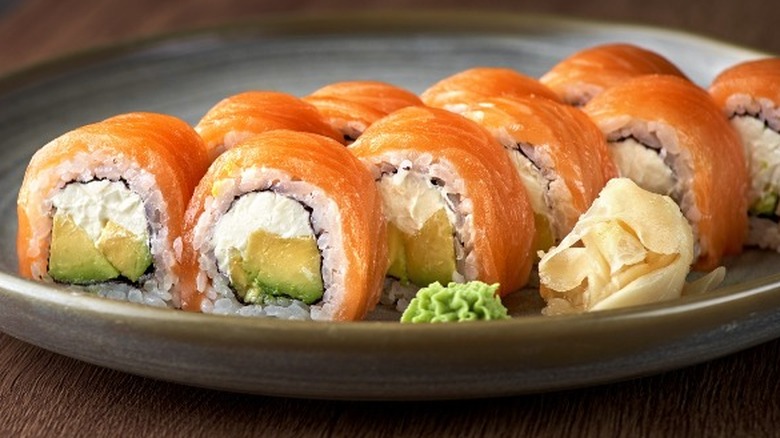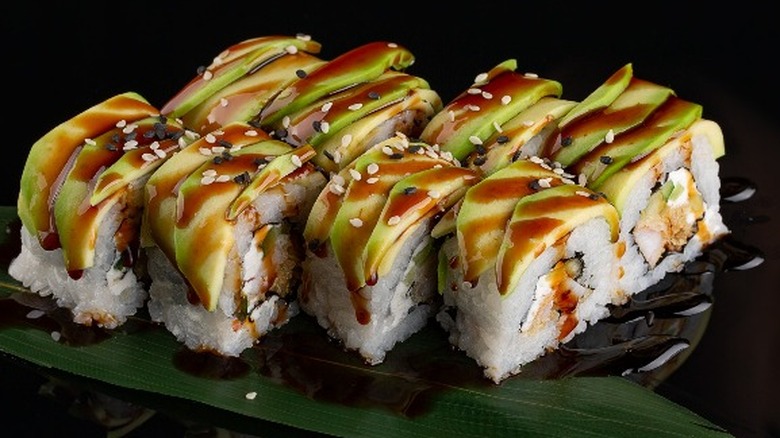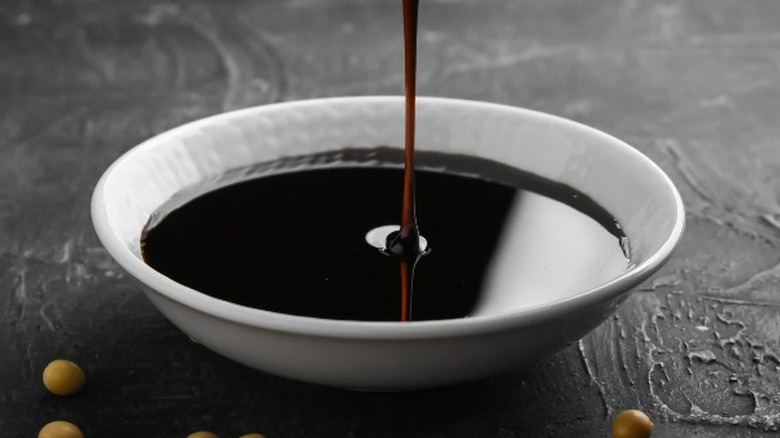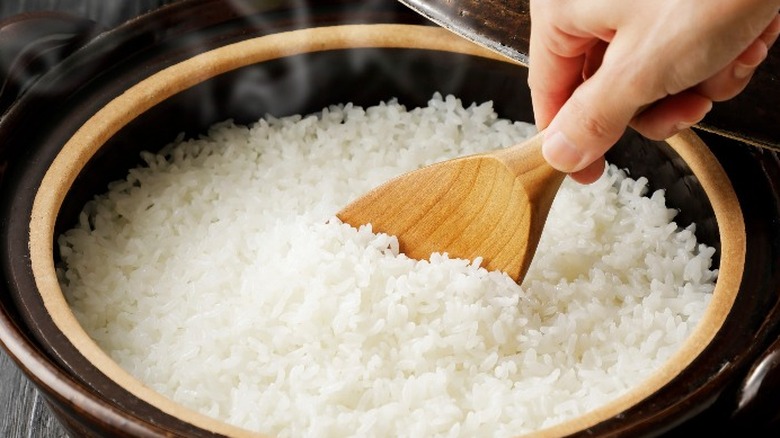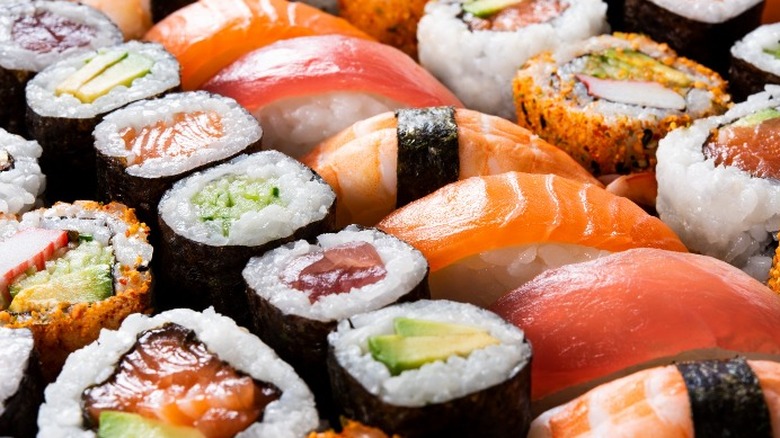7 Best Ways To Eat Sushi And Which Ways To Avoid
Sushi is a traditional Japanese dish that combines rice with raw seafood, vegetables, egg, and other accompaniments (via Britannica). Although the rice is cooked and seasoned with vinegar, sushi is typically served cold with fresh wasabi (Japanese horseradish) and pickled ginger as a palate cleanser (per Eat-Japan).
In the United States, sushi has steadily gained popularity from the time the first sushi restaurant opened in Los Angeles in 1966 to today (via the Michelin Guide). While Kawafuku catered mostly to Japanese immigrants living in Los Angeles at that time, many other establishments soon followed, serving up sushi and other Japanese-inspired cuisine to a broader audience. An article published in Food and Foodways adds that "[b]y the late 1960s, sushi had become a staple of high-end U.S. dining."
Although some may not find raw fish appealing, people have been eating some form of sushi dating back to between the third and fifth centuries B.C. (via History Today). In fact, experts have shared that sushi has nutritional benefits that can help boost your overall health (per Men's Health).
However, today's sushi restaurant menus are filled with options that have evolved far beyond traditional sushi, often veering off the healthy path. So, what are the best sushi choices when trying to keep your health on track? Here are the best and worst ways to eat sushi.
Order salmon for heart-healthy fats
One nutrient-dense fish you should add to your must-have sushi options is salmon. Rich in omega-3 fatty acids and packed with protein, vitamins, and minerals, salmon can actually reduce the risk of developing certain health conditions, including heart disease (via Healthline). According to the U.S. Department of Agriculture (USDA), 100 grams of farmed salmon provides about 2.3 grams of omega-3 fatty acids, which satisfies the recommended daily intake of 1.6 grams in males and 1.1 grams in females ages 19-50 (via Office of Dietary Supplements).
Omega-3 fatty acids help to reduce inflammation in the body and provide several benefits for the cardiovascular system, including lowering blood pressure, decreasing unhealthy fat and cholesterol in the blood, lowering the risk of heart attack and stroke, and reducing the risk of blood clots (per Mayo Clinic). Apart from omega-3s, salmon is also an excellent source of vitamin D, vitamin B12, niacin, and selenium (via NutritionValue.org).
You can order traditional salmon nigiri sushi, which is a cut piece of salmon over a bed of sushi rice with some wasabi, as described by MasterClass. Otherwise, restaurants generally offer several rolls that feature salmon as the star of the show.
Choose whitefish menu items for lean protein
Whitefish is not a fish species. Rather, the name refers to a group of similar fish that are known for mild, sweet flavors and light-colored meat (per Seafood Nutrition Partnership). Whitefish, like halibut and snapper, are typically high in protein and low in harmful saturated fats (via the National Health Service), making them a good choice when scanning the sushi menu for healthier options.
The proteins found in halibut and many other whitefish are considered complete proteins because they contain all essential amino acids the human body does not produce on its own (via WebMD). As explained by Cleveland Clinic, protein is necessary to carry out several bodily functions, including the formation of muscle, building and repairing tissue, and transporting nutrients to cells. Consuming complete proteins means you're getting an array of crucial amino acids that assist with everything from histamine production to better mood and sleep regulation.
As Chef Tom Nozawa of Sugarfish explains in a Thrillist interview: "Sushi chefs have always loved the fin section of the halibut for its unusual texture and surprisingly rich taste from a lean fish." As a chef favorite, you will most likely find halibut and other whitefish at most sushi restaurants prepared in different ways.
Have your roll wrapped in cucumber with no rice
Watching your carbs? You're not alone. The Harvard School of Public Health notes that low-carb diets, including the Atkins, Paleo, South Beach, and ketogenic or "keto" diets all focus on restricted carb intake to aid with weight loss. You may also fall into the category of limiting carbohydrates for specific health reasons, such as keeping your blood sugar levels from spiking if you are diabetic (per the American Diabetes Association).
Whatever the reason for wanting to avoid carbs, sushi rice can quickly derail your plan. Just one cup of cooked sushi rice contains about 49 grams of carbohydrates, which is about 16% of the recommended daily value (via Nutritionix). Although not all carbohydrates are inherently bad (per Healthline), you may want to be smart about your sushi selection if you need to restrict your carb intake.
Naruto-style rolls are prepared in a way that typically has no rice and are wrapped in cucumber, so they are a low-carb sushi option (via Cleveland Clinic). Moreover, cucumbers are low in carbs and calories and a good source of many essential nutrients, including vitamin K, vitamin C, potassium, and manganese (via Healthline).
Don't skimp on the wasabi
Wasabi is a perennial plant that is part of the mustard family and is traditionally ground into an aromatic paste and served with sushi (per Britannica). But as it turns out, wasabi is more than just a tasty Japanese condiment. It also offers several benefits that may support your health, including antibacterial effects and anti-inflammatory and anti-cancer properties (via Healthline).
However, what we call "wasabi" in the United States rarely contains real paste from the wasabi plant (via WebMD). Because authentic wasabi can be expensive and have a comparatively short shelf life, most wasabi in the U.S. is made using horseradish, green food coloring, and other ingredients to mimic the real thing.
With that said, there are still health benefits to the horseradish-based wasabi you're most likely to find in sushi restaurants (per WebMD). You'll get trace amounts of iron and potassium, which can lower your risk of developing anemia and high blood pressure. Whether the restaurant serves freshly ground wasabi or the more widely available horseradish paste with your sushi, it definitely doesn't hurt to indulge.
Add avocado to your rolls
Although avocado was not always associated with sushi, the California roll, which contains avocado, introduced Americans to this tasty combination in the late 1960s (via The Michelin Guide). As the story goes, a Japanese sushi chef in California did not have tuna belly for a roll (via The Japan Times). Instead, he used king crab with avocado to recreate the fatty texture of the original menu item. From there, avocado in sushi gained popularity, and has since become a widely accepted ingredient.
Today, you can add avocado to just about any roll if it doesn't already contain it in the original recipe. Why? Avocados are a great source of several health-boosting nutrients that can help you feel your best (via Medical News Today). They provide omega-3 fatty acids, vitamins K, C, and E, fiber, magnesium, potassium, and other vitamins and minerals. Many of these nutrients can lower your risk of developing health conditions, including osteoporosis and cancer (per Medical News Today).
Try brown rice sushi
Short-grain white rice is typically used to make sushi (via Food Network). As described by Women's Health Magazine, rice goes through a process of removing the husk, germ, and bran, turning it into "white" rice. However, this means white rice is stripped of much of its nutritional and fiber content, which is what helps to regulate hunger, blood sugar levels, and bowel health (via The Mayo Clinic). White rice is also refined and polished to look more uniform and appetizing (per Healthline).
On the other hand, brown rice is a whole grain that maintains its nutrients with minimal to no processing (via WebMD). With the bran and germ still intact on brown rice, you get all the fiber, vitamins, minerals, and antioxidants not found in white rice, including iron, calcium, B vitamins, phenols, and flavonoids.
Because brown rice is low on the glycemic index, it allows you to get energy-packed carbs without spiking your blood sugar (via Healthline). The high fiber content in brown rice also makes you feel fuller longer, which may help with maintaining your weight.
Although some sushi restaurants offer brown rice as a substitute for those wanting to avoid white rice, you should expect the taste and consistency to be quite different from what you're used to when eating your favorite sushi dishes (via NPR). However, the nutritional benefits of swapping out white rice for whole-grain brown rice outweigh those differences for many people.
Order sashimi if you're cutting carbs
If you're trying to stick to a low-carb resolution to get your weight under control or your health back on track, you may want to peruse the sashimi selection at your favorite sushi restaurant. While sushi is made with vinegar-marinated rice, sashimi only consists of thinly sliced, high-quality raw fish (per Healthline). Most Japanese establishments that offer sushi will also have sashimi available on their menus.
Because sashimi is not served with rice, you get the protein and healthy fats of the fish without the carbohydrates. According to Restaurant Clicks, some popular sashimi fish include tuna, yellowtail, salmon, mackerel, and halibut. These fish are packed with nutrients that may help to lower your risk of heart disease and improve brain function (per Healthline). Fish are also a natural source of vitamin D, which many Americans are lacking, according to an article in Nutrition Research.
Skip deep-fried rolls with added calories and fat
While deep-fried rolls may be tasty, they are packed with empty calories and fat that could lead to health problems (via Healthline). Even vegetable rolls can be unhealthy if they are deep-fried. Fried sushi rolls you may want to avoid or moderate include any roll that contains tempura, which is made using a Japanese cooking technique that involves light breading and deep frying (per MasterClass). Other restaurants may deep fry the entire roll rather than simply including fried elements in the recipe.
A review published in Nutrients shares the health risks of fried food consumption, including cardiovascular disease, diabetes, hypertension, and obesity. The Mayo Clinic also shares that overeating fried foods could even lead to early death. The risk of death in women over 60 who consume fried fish or chicken at least once a day goes up by about 13%.
Instead of a deep-fried sushi roll, go for one with fresh fish, added vegetables, and no fried ingredients. You can still enjoy the satisfying flavors of the roll without the harmful fats found in fry oils. If you do decide to indulge in moderation, Harvard Health suggests choosing foods fried in vegetable oils rather than animal fats.
Avoid fish with high levels of mercury
Another thing to keep in mind when deciding what kinds of sushi you want to eat is the mercury content in the fish. As explained by Healthline, mercury is present in the environment, including in our water. Fish and shellfish often absorb some of the mercury found in water as a result of pollution and diet. Some types of fish have higher mercury levels, which can be harmful to the kidneys and nervous system when consumed (via WebMD).
Depending on water pollution levels and the type of fish, mercury can build up in the fish's body and reach toxic levels (per Healthline). In general, larger fish will have a higher concentration of mercury because they consume smaller fish that already have mercury in them, which a study in the Archives of Environmental Contamination and Toxicology describes as mercury biomagnification.
Fish with the highest mercury levels include swordfish, tilefish, king mackerel, bigeye tuna, marlin, and Chilean sea bass (via WebMD). To avoid consuming toxic levels of mercury, the Natural Resources Defense Council (NRDC) suggests avoiding sushi made with larger, predatory fish, especially if you are pregnant, nursing, or planning to become pregnant, as mercury can be incredibly harmful to a baby's developing brain (per Mayo Clinic).
Pass on Philadelphia rolls filled with saturated fats
The popular Philadelphia sushi roll is a play on the classic bagel and lox combination, made with salmon and cream cheese (via Delish). Although it contains heart-healthy salmon, the Philadelphia roll's defining ingredient is cream cheese, which does not offer much in the way of health benefits (via Healthline).
Traditional cream cheese is densely packed with calories and saturated fats — even in smaller serving sizes (via Food Network). A Philadelphia roll recipe by Tasty calls for 4 ounces of cream cheese, which contains an alarming 23 grams of saturated fat — 115% of the recommended daily intake (via NutrionalValue.org). According to the American Heart Association (AHA), saturated fats can increase cholesterol levels and increase your risk of developing heart disease. The AHA recommends no more than 13 grams of saturated fat consumption per day.
However, whipped versions of cream cheese contain fewer calories and fat than the classic spread (per Healthline). If the sushi restaurant uses whipped cream cheese to make their Philadelphia rolls, it's something you may want to consider in moderation.
Avoid rolls covered in heavy sauces
Rolls smothered in heavy sauces, like eel sauce or spicy mayo, can be high in sugar and fat. Just one tablespoon of eel sauce has 6.4 grams of sugar (via Nutritionix), while one tablespoon of spicy Japanese mayo contains about 7% of your recommended daily intake of saturated fat (via Nutritionix). These heavy sauces can also make the calories add up quickly when enjoying what you thought was a light meal.
In a Michelin Guide interview, Chef Yohei Matsuki of Los Angeles-based Sushi Ginza Onodera says, "American consumers are more interested in seeing a novel approach to sushi with different sauces." While these flavorful sauces can add complexities to some sushi rolls, Chef Matsuki explains that they can also take away from the subtlety and delicate textures of the fish.
To help you avoid the unnecessary sugar and fat in sushi roll sauces, you can try ordering the sauces on the side to have more control over how much you consume. Otherwise, it might be best to hold the sauce altogether or order a lighter roll.
Don't drench your sushi in soy sauce
Soy sauce is a popular Asian condiment and cooking ingredient made with fermented soybeans and wheat (via Healthline). The aging and fermentation process used to make soy sauce creates bold flavors and a distinctive aroma that goes well with many foods, including sushi.
Although it's standard to dip your sushi in soy sauce, you don't want to overdo it. Soy sauce is high in sodium, which can affect your cardiovascular health. According to the Centers for Disease Control and Prevention (CDC), too much sodium or salt intake can cause high blood pressure, which increases the risk of suffering a heart attack or stroke.
To avoid adding too much sodium to your sushi, Eat-Japan recommends lightly dipping the fish portion of the sushi in soy sauce rather than the rice. The texture of the rice will absorb more soy sauce, making it too salty. Simply pick up your sushi sideways or upside down to make it easier to avoid dipping the rice in the soy sauce. You can also try soaking pickled ginger in soy sauce then running the ginger over your sushi to add flavor, instead of dipping the sushi itself into the soy sauce.
Limit how much rice you consume
When enjoying sushi while dining out, you might not realize that the nigiri sushi or rolls you've ordered are packed with excessive amounts of rice. In moderation, sushi rice is generally not a problem for most people. However, too much white rice can cause blood sugar levels to spike, putting you at risk of gaining weight and developing diabetes (via Women's Health Magazine).
White rice contains refined or simple carbohydrates, which means the fiber has been removed through processing (per Healthline). Refined carbs are high on the glycemic index, which means they digest quickly and can cause insulin levels to become imbalanced (via Medical News Today). An article in the American Journal of Clinical Nutrition shows a connection between the consumption of refined carbs in the United States and increased numbers of type 2 diabetes cases.
To help balance your rice intake, you can ask for easy rice in your rolls and sushi. You may also want to consider no rice or sashimi options available on the menu.
Pace yourself at all-you-can-eat sushi restaurants
As explained by The Takeout, all-you-can-eat (AYCE) sushi restaurants allow patrons to pay per person to get an unlimited amount of sushi versus having to pay per order. While this might be a great option to save money, it could also lead to overindulgence, which can be harmful to your health in the long run (via Healthline).
According to Keck Medicine of USC, regular overeating caused by binge eating disorders puts you at risk of weight gain, heart disease, type 2 diabetes, gallbladder diseases, and depression. The article also points out that binge eating disorders, which are overeating at least once a week for three months, are actually three times more common than anorexia and bulimia combined.
Overeating can also affect your body in the short term, causing the stomach to expand and push against other organs (via MD Anderson Cancer Center). It will also lead to the organs overworking to produce extra hormones and digestive enzymes, the feeling of being full, sluggish, and tired, heartburn, and hot flashes as your metabolism speeds up to burn the extra calories.
While it's tempting to get your fill when faced with endless sushi options, try to pace yourself by ordering a few things at a time, skipping the appetizers, and getting your favorites in your first round of orders (via The Takeout).

